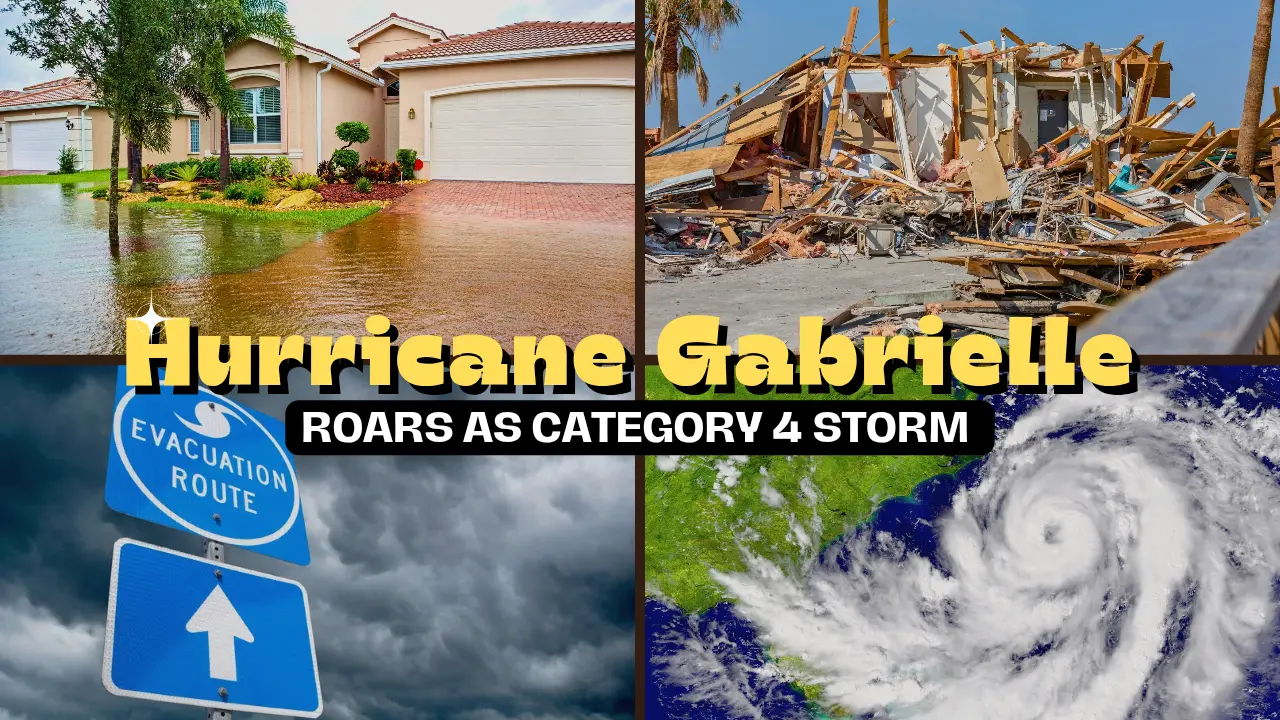Hurricane Gabrielle has intensified into a Category 4 hurricane, with 140 mph sustained winds and a central pressure of 948 mb. Tracking north-northeast at 12 mph southeast of Bermuda, Gabrielle is causing widespread concern across the Atlantic. Authorities in the UK and Portugal are closely monitoring its progress as it transitions toward a post-tropical system.
Gabrielle Strengthens to Category 4
Gabrielle’s rapid intensification underscores the volatile nature of the 2025 Atlantic hurricane season.
Storm Details:
- Category: 4
- Sustained Winds: 140 mph
- Central Pressure: 948 mb
- Movement: North-northeast at 12 mph
- Location: Southeast of Bermuda
Meteorologists warn that Gabrielle’s well-defined eye and expanding radius could impact maritime and coastal regions significantly.
Atlantic Impact: Florida, Bahamas, and East Coast
Even without making landfall, Gabrielle is already affecting the U.S. East Coast, Florida, and the Bahamas.
Forecast Highlights:
- Florida Waves: 3 ft at 10-second intervals, peaking in the afternoon
- Swell Direction: Mostly north of South Florida due to Bahamas acting as a barrier
- East Coast Surf: 12–13 second periods creating strong rip currents
Authorities advise caution for all coastal and maritime activities.
UK and Portugal on Alert
As Gabrielle moves north, Portugal and the UK are watching for tropical storm-force winds.
Safety Measures Include:
- Securing outdoor property
- Monitoring official weather updates
- Avoiding travel in coastal and low-lying areas
This rare transatlantic impact highlights how powerful storms can affect Europe even at post-tropical stages.
Also Read: Met Office Weather Warning: Your Essential Guide
Tropical Activity Heating Up
The National Hurricane Center is tracking two more tropical waves. One may develop into an Erin-style system near the coast, and long-range models suggest potential formation near the Yucatán. These developments mark an active and unpredictable hurricane season.
Historical Context: Gabrielle and the Azores
Hurricanes rarely reach the Azores at hurricane strength. The last event occurred in 2016, emphasizing Gabrielle’s significance.
| Year | Storm | Status at Azores |
| —- | ——— | ————————————- |
| 2016 | Alex | Hurricane |
| 2025 | Gabrielle | Hurricane (approaching post-tropical) |
Residents and maritime operators are advised to remain alert as Gabrielle approaches.
Tracking Gabrielle: Safety Tips
Essential Precautions:
1. Stay updated with official channels and the National Hurricane Center
2. Keep emergency kits ready with essentials such as water, food, and medications
3. Secure property and outdoor items
4. Avoid coastal travel during peak storm conditions
Authorities provide real-time tracking to ensure safety for all potentially affected regions.
Atlantic Hurricane Season Intensifies
Gabrielle’s rapid escalation highlights the intensifying Atlantic hurricane season. With multiple tropical waves and potential new systems forming, vigilance is crucial. Early preparation, awareness, and adherence to official advisories can help minimize risks.
FAQs on Hurricane Gabrielle
1. What category is Hurricane Gabrielle currently?
Gabrielle is a Category 4 hurricane with sustained winds of 140 mph.
2. Which areas are most at risk?
Florida, the Bahamas, the U.S. East Coast, Portugal, and the UK.
3. When was the last hurricane to hit the Azores?
The last hurricane landfall in the Azores was in 2016.
4. How strong are winds and swells?
Winds reach 140 mph; Florida swells 3 ft at 10-second intervals, East Coast 12–13 second periods.
5. What precautions should residents take?
Monitor updates, secure property, avoid coastal travel, and prepare emergency supplies.
Hurricane Gabrielle: Preparing for the Storm
From Category 4 intensity in the Atlantic to potential impacts in Europe, Hurricane Gabrielle highlights the importance of preparedness. Residents, authorities, and maritime operators must follow official updates and safety advisories closely to minimize risks.

















